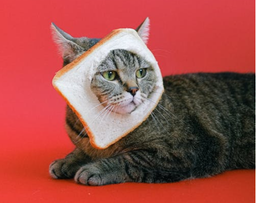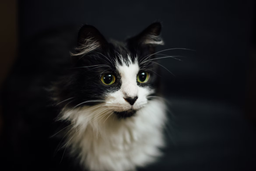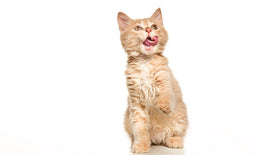Do Ragdoll cats eat a lot? Learn how much you should feed your feline to keep them fit
Ragdoll cats are larger than the average domestic cat, so it’s a common belief that they need more food for their basic upkeep. Unfortunately, the situation is not that simple.
This gorgeous, cuddly, and affectionate breed favours a sedentary lifestyle and doesn’t spend as much energy as active cats, like Bengals or Siamese, do. Since Ragdolls are inactive for most of the day, they are prone to obesity, and unhealthy food and snacks must be kept to a minimum.
Untamed explains the quantity and quality of food your gentle giant needs to stay happy and healthy. Do Ragdoll cats eat a lot? Find out in our comprehensive guide.
Some basic facts about Ragdolls’ nutritional needs
Ragdolls are mostly lap cats happy to spend their time indoors, curled up next to their human. Running around outside, climbing trees, or hunting is usually not on their to-do list.
This does not mean that they are completely inactive. Ragdoll cats have short bursts of energy in between extended naps. They love playing with their family members and toys or exploring the house.
Ragdoll cats need a few more calories than most breeds because of their size.
Check out the table to see how Ragdolls compare to other popular breeds in weight:
|
Breed |
Average weight (in kg) |
|
Ragdoll male |
5–9 |
|
Ragdoll female |
4–7 |
|
Siamese male |
3–6 |
|
Siamese female |
2–5 |
|
Persian male |
4–6 |
|
Persian female |
3–5 |
Since they spend a lot of time chilling, Ragdolls tend to pile on extra weight, especially if fed unhealthy food and snacks. An optimal diet for your feline companion consists of:
- Animal protein
- Animal fat
- Water
- Vitamins and minerals
Animal protein must make up more than 50% of your cat’s diet, while animal fat should not exceed 20%. Carbohydrates are a common ingredient in commercial cat food, but your cat’s diet must contain less than 3% carbs.

And now, I must rest…
Source: Kadisha
How many calories does a Ragdoll cat need, and what if they always ask for more?
Adult Ragdoll males need around 350 calories daily, while females should be fine on 250. As obligate carnivores, cats should get their energy from animal protein, so your feline needs to eat meat to stay fit.
If your Ragdoll eats nutritious, protein-rich food, they won’t feel the need to overeat. Two to three regular meals a day are enough to keep them healthy and full, especially if you serve high-quality cat food.
If your furry friend is hungry all the time, you should take them to the vet. Bingeing on food can be a sign of an underlying condition or a behavioural issue. The cravings indicate that there is a potential problem with their diet. Here are the usual reasons why your Ragdoll cannot stop eating:
- Intestinal parasites
- Diabetes
- Hyperthyroidism
- Age and growth rate
- Fast metabolism
- Pregnancy
- Anxiety, depression, and boredom
- Low-quality food
Intestinal parasites
Although they mostly stay indoors and get regular deworming meds, Ragdolls can still get infected with parasites.
If worms get into your cat’s digestive system, they consume most nutrients your kitty has ingested. Even if your Ragdoll cat is on a nutrient-dense diet, they will always be hungry since the parasites feast on the best parts of their meals.
If you suspect your feline friend may have worms, a trip to the vet will help. They will run the necessary tests and recommend the appropriate treatment and preventive measures.
Diabetes
Cats suffering from diabetes can constantly feel unsatiated. Their energy levels are low because the pancreas doesn’t produce enough insulin. If you think your feline may be diabetic, take them to the vet to get the exact diagnosis and treatment.
Diabetes is not uncommon in cats, and it often goes undiagnosed for a long time. Insulin injections will help manage the disease, and your furry friend’s appetite will go back to normal.
Hyperthyroidism
Hyperthyroidism often affects older cats. The condition makes your cat's thyroid gland hyperactive and speeds up the metabolism. Your cat may digest food faster than normal, making them constantly hungry and thirsty.
They may lose weight despite having an increased appetite and eating more than usual. A vet will run blood tests to determine if hyperthyroidism is the culprit. They will recommend medication and suggest appropriate dietary and lifestyle changes to manage this disease.
Age and growth rate
Kittens tend to be hungry all the time because they grow rapidly. Cats under 18 months like to try everything they can get their paws on, so it's crucial to give them only high-quality food and healthy snacks.
Ragdoll kittens grow at an even faster pace, so they are constantly hungry. The situation stabilises when they reach two. Most vets recommend free feeding for Ragdoll kittens.
Fast metabolism
Some cats have a fast metabolism. Their bodies break down and absorb nutrients much faster, making them constantly hungry. If your feline friend has a fast metabolism, they will demand food from you, and if you don’t give in, they are likely to become vocal and annoying.
To determine if your kitty has a fast metabolism, compare the amount of food you give them with their weight. If they eat more than recommended, but their weight remains healthy, their metabolism is probably fast. Ragdoll cats are usually not that lucky, and this breed is more prone to obesity.
Pregnancy
If your cat is pregnant, their appetite will increase. As the litter grows, so will the hunger. Your pregnant feline should eat more, but the portions must still be controlled. The quality of food is essential to help them go through the pregnancy easily and deliver healthy kittens.
Your lactating queen will need more energy while breastfeeding, so don't go back to her regular meal plan until the kittens are weaned off.
Anxiety, depression, and boredom
Ragdoll cats are emotional eaters and likely to overeat when they feel anxious or depressed. They also tend to swap playtime with mealtime and eat whenever they feel bored. Depression and anxiety come from stress, so if your Ragdoll is overeating, pay attention to the potential stressors in their environment, including new pets, family members, loud noise, or changing houses.
Even a change in your routine can cause stress, so if you're absent more than usual, make sure your kitty does not feel neglected by extending cuddle time when you are around.
Low-quality food
Ragdoll cats require a nutritious diet high in protein and moisture. If their meals lack essential nutrients, they will be hungry soon after eating.
Low-quality cat food often contains fillers like grains, corn, potatoes, and rice, which are unnecessary and potentially harmful (if consumed in excess). Ragdolls, in particular, are at risk of becoming overweight if they live on high-calorie food because of their sedentary lifestyle.

When will mum be home? I’ve been waiting since breakfast.
Source: Woodsilver
Ragdoll cats and available food types
The most popular food types for Ragdoll cats are:
Dry food, also known as cat kibble, is the cheapest option. Unfortunately, it is highly processed and lacks moisture, so if you choose to give it to your cat, add some broth or soup to the biscuits. A dry-food diet is a subpar choice because kitty biscuits tend to be full of carbs, which are useless for your cat. Ragdolls on kibble tend to eat more because they don't get the essential nutrients from their meals.
Semi-moist products contain more moisture than dry food but are usually loaded with artificial flavours and useless fillers. If your kitty eats a lot of semi-moist food, it's because the product is of poor quality.
High-quality wet food is the best option for your cat. It is high in protein and moisture and closely resembles your cat’s natural diet. Most cats like wet food because it’s tasty, but if your cat refuses to eat it, you can mix it with kitty biscuits to keep your feline friend happy and fit.
What is the best diet for my Ragdoll cat?
Your Ragdoll should eat two to three wet meals per day. Their food should be based on whole meat because cats absorb all the necessary nutrients from it easily. Set up strict meal times and refrain from giving too many treats as they shouldn't exceed 10% of your feline's daily food intake. Most vets advise against free-feeding adult Ragdolls.
High-quality wet food usually comes in gravy or jelly formulas. Everything you need to know about a specific product is on the label. Check out the table below to learn to decipher cat food labels:
|
What to check |
How to recognise good products |
|
|
|
Guaranteed analysis |
|
|
To keep hunger under control, treat your cat to Untamed
Untamed offers various tasty meals packed with nutrients to keep your Ragdoll cat full and healthy. Vets have developed our recipes to ensure they are balanced and complete.
Our dishes are ready to serve, and they taste and smell so great that even the fussiest kitties won't be able to resist them—here’s why:
- We use the best ingredients—Untamed opts for human-grade meat, including chicken breast, liver, ham, salmon, prawn, shrimp, sardines, and tuna
- Our food is rich in protein—Untamed dishes contain twice more protein than the industry standard and are packed with taurine and other essential amino acids
- Every meal is gently steamed—Overcooking can spoil the taste and strip the food of the nutrients. We simmer our dishes gently to lock the aroma and nutrients in a yummy delicacy
- Common allergens are off the menu at Untamed—Cats are prone to digestive issues, and their stomachs can get upset by iffy ingredients. Our meals are free from all common allergens, making them safe for cats with sensitive tummies
Head over to our Try Now page and tell us about your feline friend. We can create a tailor-made meal plan together.

Untamed cat food is packed with nutrients, and oh so yum!
Image (c) Untamed
The results speak for themselves!
Untamed will help your Ragdoll develop healthy eating habits and stay fit.
Here’s what to expect after switching your cat to Untamed:
|
Timeline |
Benefits |
|
One week |
|
|
Two months |
|
|
Four months |
|
|
Six months and beyond |
|
Ordering Untamed is super easy
You don’t have to leave your home (or your furry friend) to get your stash of Untamed meals. You can order our cat food online by following these easy steps:
- Visit our Try Now page
- Tell us about your cat
- Select a meal plan and place an order
Untamed’s taster pack will be delivered to your door within a day. If your cat approves, we will replenish your stock every month at the same time, so your pantry is always full. You can modify, pause, or cancel your cat food susbcription at any time.
Not only is our food delicious and nutritious, but we strive to save the environment. Untamed runs carbon-neutral operations and uses only recyclable packaging. All our ingredients come from sustainable and dolphin-safe suppliers.
The best treats for Ragdolls
If your furry friend wants a snack between meals, the best choice would be lean meat.
Some feline favourites include:
Ham and bacon must be served in moderation because they are high in fat.

Mmmm, that was good. When can I have some more?
Source: Woodsilver
Always cook the meat before serving. There are some benefits to raw chicken and other meat, but the risks are also high. Unlike fresh prey, meat from the human supply chain has been stored, frozen, and defrosted, so the chances of contamination are high.
You can occasionally give your Ragdoll feline-safe fruits and veggies as a treat but remember that plants hold no nutritional value for cats. Vegan and vegetarian diets are not compatible with the feline digestive tract, and your furry friend will struggle to digest these ingredients and absorb the nutrients. If your Ragdoll cat is overweight, fruits and veggies won't help them get fit because cats cannot process carbs, which are stored as fat in their bodies.
Safe fruits and veggies include:
|
Fruits |
Veggies |
|
Before giving your feline friend fruits and veggies, wash them thoroughly. Remove the skin, seeds, stems, and leaves and cut the product into bite-sized pieces. Serve in moderation and monitor your kitty for signs of gastrointestinal discomfort or allergic reactions.

Strawberries are on the feline-safe list and can be enjoyed in moderation.
Source: Pixabay
Forbidden foods
Specific products are toxic to cats and should never be fed to them. The tiniest amounts can provoke adverse reactions.
Depending on the type of food, your cat might suffer from vomiting, diarrhoea, lethargy or more severe issues like kidney damage and respiratory problems. The forbidden food list includes coffee, chocolate, alcohol, citrus fruits, grapes, raisins, onions, and garlic.
While cats usually like milk and dairy, most felines cannot digest lactose, so it’s best to avoid giving these products even as a treat.

![Best food for Ragdoll cats in the UK [Broken Down]](http://untamed.com/cdn/shop/articles/featured_best_food_for_ragdoll_cats_uk.jpg?v=1646818249&width=256)

